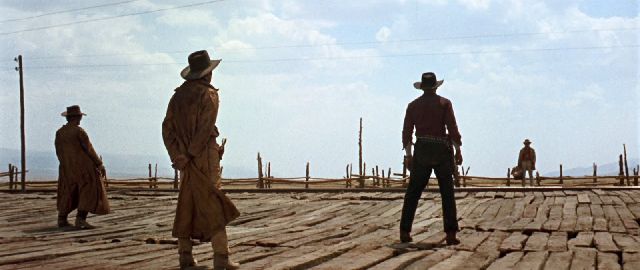Once Upon a Time in the West (1968) 
“There were three men in her life. One to take her… one to love her… and one to kill her.”

Director: Sergio Leone
Cast: Henry Fonda, Charles Bronson, Claudia Cardinale
Synopsis: Epic story of a mysterious stranger with a harmonica who joins forces with a notorious desperado to protect a beautiful widow from a ruthless assassin working for the railroad.
By 1968, director Sergio Leone felt he had said everything he had to say about the Western genre in the trilogy of ’Man With No Name’ spaghetti westerns starring Clint Eastwood. In fact, he was already planning to make the movie that would eventually become Once Upon a Time in America in 1984, but the opportunity to work with his idol Henry Fonda proved too strong to resist and he agreed to make Once Upon a Time in the West, considered by many to be his finest work. The movie contains all the familiar Leone trademarks: the lingering close-ups of sweaty faces, the sun-blasted landscapes, the sudden bursts of violence, all accompanied by an epic Ennio Morricone musical score that ranges from dramatic to romantic to vaguely comical. And yet there’s something missing from Once Upon a Time in the West, some elusive, indefinable ingredient which prevents it from quite matching up to his other Westerns.
The rise in Leone’s status is reflected in the quality of the cast in Once Upon a Time in the West (Eastwood was a jobbing actor unsuccessfully attempting to shed his Rowdy Yates image in Hollywood when he made A Fistful of Dollars (1964), the first of his three collaborations with Leone). Not only does Leone have Fonda to direct, but also Jason Robards, Charles Bronson and Claudia Cardinale in major roles.
Bronson plays Harmonica, named after the musical instrument on which he plays a haunting melody which serves as his signature tune. He arrives at the Flagstone railway station to be greeted by three gunmen (Jack Elam, Woody Strode and the wretched addict Al Mulock who threw himself from a hotel roof during filming because he couldn‘t get a fix.) sent by a man called Frank (Fonda). Surviving his encounter with them, Harmonica next shows up at a remote trading post. Jill McBain (Cardinale), who is soon to discover that Brett McBain (Frank Wolff), the husband to whom she has travelled out West to set up home with has, together with his children, been slaughtered by Frank and more of his gunmen, also stops at the trading post just as on-the-run desperado Cheyenne (Jason Robards) arrives. The lives of these three disparate characters intertwine in violent and unexpected ways with Frank, who has been employed by crippled railroad tycoon Morton (Gabriele Ferzetti) to remove obstacles like Brett McBain, who stand in the way of the railroad line he is building from the Atlantic to the Pacific.
Although it shares many of the characteristics of his earlier Spaghetti Westerns – and the plot devices of The Good, The Bad and the Ugly in particular – Once Upon a Time in the West is very different in tone. It’s more downbeat and sombre, and its characters share a jaded cynicism fashioned by the cruel realities of life in the West. If Leone was done with the Western before Fonda came along, it’s entirely possible that he struggled to maintain the levels of energy and creativity for this shoot that he seemed to possess in abundance when filming the Eastwood movies. Either way, the characters here lack the depth and nuances of those in other movies. Fonda’s black-clad villain is chillingly cold and detached, and it’s terrific to see him playing against type after thirty years of good guys, but his undiluted nastiness turns him into little more than a hissable cartoon villain.
Bronson’s character is simply The Man With No Name in a different skin (Eastwood was offered the role but turned it down) and, although he gives a decent account of himself, he struggles to fill Eastwood’s dusty boots. Cardinale’s former prostitute Jill seems to be more of a symbol than a person, representing the purity of water in a rugged desert landscape, and is a mere pawn in the hands of the three male characters. Only Robards’ Cheyenne contains any hint of vitality, but even he’s a pale shadow of Eli Wallach’s Tuco, Cheyenne’s counterpart from The Good, The Bad and the Ugly.
Despite these reservations, Once Upon a Time in the West still possesses many fine qualities. It opens with a rightly famous opening sequence in which time seems to stand still as the three gunmen silently and patiently await Frank’s arrival in Flagstone. The visuals are as eye-catching as ever, and Leone captures the epic qualities inherent in a story revolving around the historic expansion of a nation – the sequence in which the camera leaves Jill as she departs the railroad station to rise above the station office and gaze down on the growing town of Flagstone is simply breathtaking. But, for the first time, it appears that Leone’s pre-occupation with style had finally begun to interfere with the requirement for a compelling story.
(Reviewed 15th August 2012)
httpv://www.youtube.com/watch?v=UdswMSFqX1E
